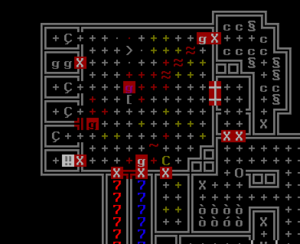- v50 information can now be added to pages in the main namespace. v0.47 information can still be found in the DF2014 namespace. See here for more details on the new versioning policy.
- Use this page to report any issues related to the migration.
Floodgate
v52.04 · v0.47.05 This article is about the current version of DF.Note that some content may still need to be updated. |
A floodgate is a gate which allows the control of the flow of liquids such as water or magma. They are operated by mechanisms such as levers or pressure plates which open and close them. When closed they behave like walls, but when opened, allow liquids, objects, and creatures to pass over them.
They can be manufactured from stone (at a mason's workshop), wood (at a carpenter's workshop), metal (at a metalsmith's forge), or glass (at a glass furnace). Once manufactured, they are built in the desired location using the keys b, x.
In most situations, simply using a door or raising bridge can be used in place of a floodgate, and provides a number of significant advantages.

Colossus in Arena
This image depicts some orthodox and unorthodox uses of floodgates to control the mixing of creatures and liquids in this arena. The gates, shown in-game as X, act as liquid stoppers and jail doors.
Uses
Floodgates are used to control the flow of liquid. Because of the usefulness of certain liquids and the danger posed by others, floodgates have a wide range of applications in any dwarven settlement.
They are instrumental in controlled irrigation for farming, or controlled flooding for drowning annoying visitors.
Floodgates also block the flow of liquid on the Z-axis as it is considered a wall when closed. This can be quite useful when built directly below a floor grate as this will allow you to quickly empty the liquid from the floor above without the danger of its precious content rummaging through your sewer system.
A pressure plate on a lower level connected to a floodgate between your main water supply and your other water controls can act as an automated safety valve to help prevent massive flooding of your lower fort. Set the pressure plate to activate (open the floodgate) when 0-1 water, which allows using the water supply. When flooding starts, the pressure plate deactivates, attempting to close the floodgate. Beware of linking multiple controllers to this floodgate, as another controller may activate opening the floodgate before this pressure resets.
Placement
Floodgates are constructed orthogonally on a solid, unflooded floor in the 'closed' position (note that this means it is possible for careless dwarves to trap themselves on the wrong side of the gate). Adjacent walls are not necessary. A mechanic must then link up a lever or other triggering mechanism to the floodgate. This requires two mechanisms; the mechanic will haul one mechanism to the floodgate, work for a while, and then haul the other mechanism to the trigger to complete the task.
You can build a floodgate over empty space, e.g. controlling water in a vertical path. First build a floor (b, C, f), after it is complete mark it for removal (d, n) and immediately designate your floodgate (b, x). You don't have to suspend either of these tasks to get both to complete. You may want to remove the stone or block left by removing the floor or it may be washed down to lower levels, possibly clogging another floodgate that is built on a floor or door.
Activation
Once the lever is pulled, with a delay, the floodgate will open. When the lever is pulled again, the floodgate will close, after same delay. This will destroy (not displace) any liquid occupying the same tile as the floodgate. Objects on the floodgate's tile, however, cannot be destroyed this way - in fact, the floodgate will refuse to close. Any object, everything from swords to socks to stones to scorpion corpses, can jam the floodgate this way. Once the object is removed, however, the floodgate will grind shut by itself. Note that the flow of liquids will often move objects downstream, and potentially jam your gate. It is advisable to clear-out any remnant stones before releasing liquids towards your gates.
Magma control
Floodgates will resist magma when closed, just as a constructed wall would, but when opened will be destroyed if they are not made from magma-safe materials. The mechanisms used in the construction of the floodgate must also be magma-safe to prevent this.
Bugs
- Floodgates built on a constructed wall remain standing (and functional) even after that wall is removed, leading to an exploitable, free-floating building. Bug:0377
"Floodgate" in other Languages
|
| Furniture | |
|---|---|
| Tools | |
| Access | |
| Constructions | |
| Machine and trap parts |
Axle • Gear assembly • Lever • Mechanism • Millstone • Pipe section • Pressure plate • Roller • Screw pump • Support • Trap • Water wheel • Windmill |
| Other buildings | |
| Related articles | |